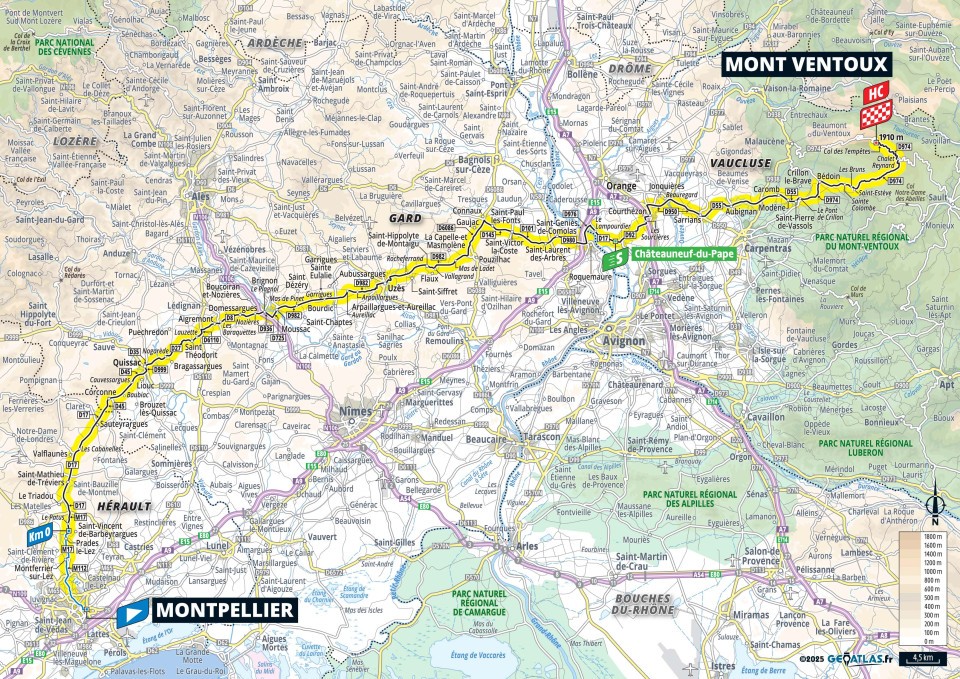As it was expected, the 16th stage (22 July 2025) of Tour de France 2025 will lead up to the top of Mont Ventoux.

MAP

As it was expected, the 16th stage (22 July 2025) of Tour de France 2025 will lead up to the top of Mont Ventoux.
Mont Ventoux, often called the "Giant of Provence," is one of the most iconic landmarks in cycling and a symbol of human endurance. Its towering presence, stark beauty, and rich history have cemented its reputation as a peak unlike any other in the world of professional cycling, particularly within the Tour de France.
Located in the Provence region of southern France, Mont Ventoux rises to 1,909 meters above sea level, standing out dramatically against the surrounding landscape. Its unique, barren summit, often described as lunar or otherworldly, sets it apart from the lush greenery of nearby mountains. The topography, coupled with the fierce winds that lash its slopes, creates a setting both intimidating and awe-inspiring for cyclists. The climb itself is relentless, featuring steep gradients that test even the strongest riders. These physical challenges have contributed to its mystique, making Mont Ventoux a proving ground for greatness.
First included in the Tour de France in 1951, Mont Ventoux quickly became a cornerstone of the race’s legend. Over the decades, it has hosted numerous dramatic moments that have captivated fans and defined careers. It is a mountain of extremes, where triumph and tragedy are closely intertwined. One of the most poignant examples is the tragic death of British cyclist Tom Simpson in 1967, who succumbed to exhaustion and dehydration near the summit. His story serves as a somber reminder of the mountain's unforgiving nature and the immense physical toll it exacts.
Conversely, Mont Ventoux has been the stage for unforgettable victories. Cyclists such as Eddy Merckx, Marco Pantani, and Chris Froome have etched their names into the mountain's legacy, conquering its slopes in displays of determination and tactical brilliance. These victories highlight the duality of Ventoux: it is a place of immense suffering, but also of transcendent achievement.
Beyond its role in competitive cycling, Mont Ventoux holds cultural and symbolic significance. Its prominence in the landscape and its historical ties to local communities imbue it with a sense of permanence and identity. For many, the mountain represents a metaphor for life’s struggles and triumphs, an enduring symbol of perseverance against all odds.
In cycling and beyond, Mont Ventoux stands as a monument to the indomitable spirit, its iconic status woven from the threads of history, nature, and human endeavor.
ON THIS DAY IN TOUR DE FRANCE HISTORY
1951 Tour de France visits Mont Ventoux for the very first time
,
VINTAGE TOUR DE FRANCE IMAGE OF THE DAY

TOUR DE FRANCE MEETS HISTORY
Petrarch’s Ascent of Mont Ventoux: A Landmark in Renaissance Thought
On April 26, 1336, the Italian scholar and poet Francesco Petrarca—commonly known as Petrarch—undertook a remarkable journey: the climb of Mont Ventoux, a towering peak in Provence, France. While scaling a mountain may seem mundane today, Petrarch's ascent is often considered the symbolic beginning of the Renaissance's humanist spirit.
In a letter recounting the experience, addressed to his former confessor Dionigi di Borgo San Sepolcro, Petrarch describes both the physical challenge and the spiritual reflection the climb inspired. Reaching the summit, he opened his copy of St. Augustine’s Confessions and read a passage warning against placing too much value on worldly pleasures. This moment of introspection turned the climb into more than a physical conquest—it became a metaphor for the soul’s journey toward higher understanding.
What sets this account apart is Petrarch’s awareness of nature for its own sake, rather than merely as a backdrop to theological concerns. His detailed observation of the landscape and his personal reflections mark a shift in attitude that prefigures the Renaissance emphasis on individual experience and a rediscovery of classical ideals.
Petrarch's climb of Mont Ventoux thus remains a powerful emblem of the humanist awakening—where personal experience, nature, and classical learning converge in the quest for meaning.